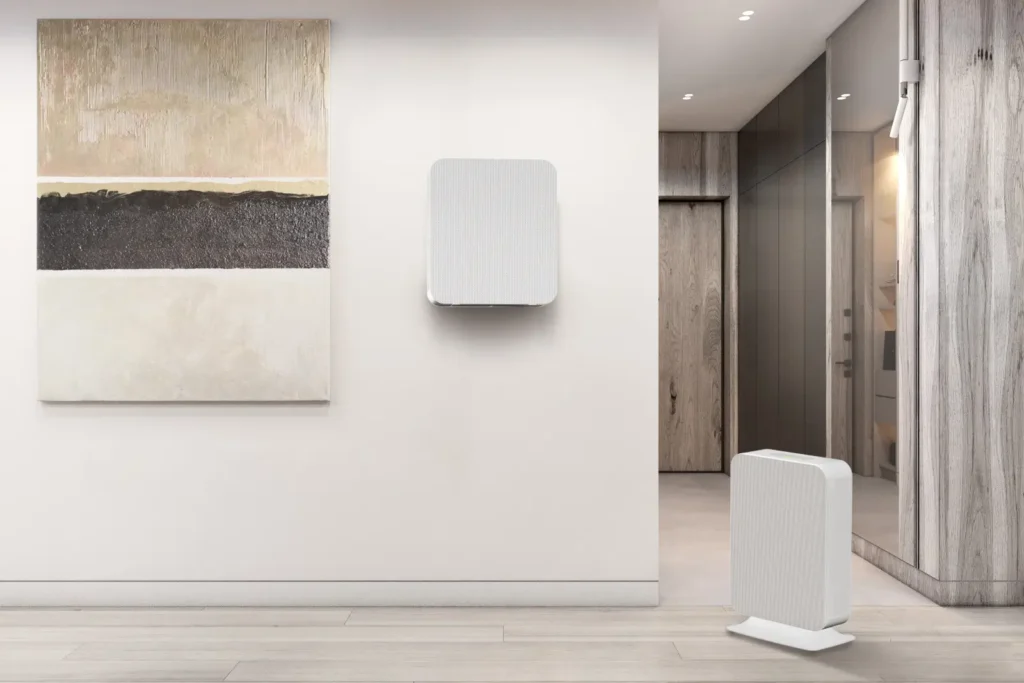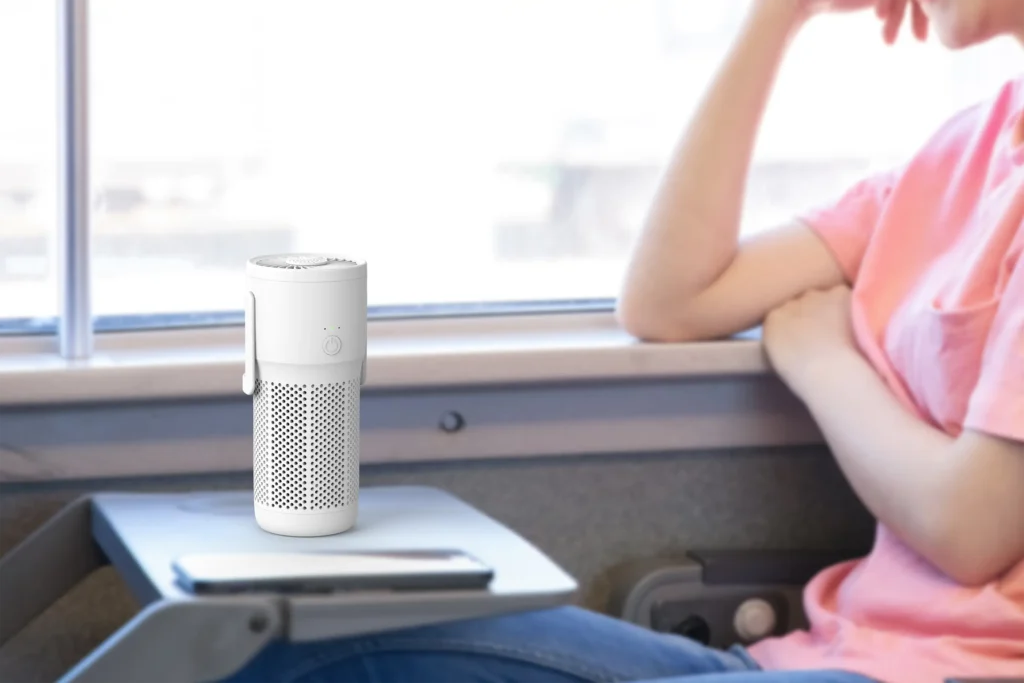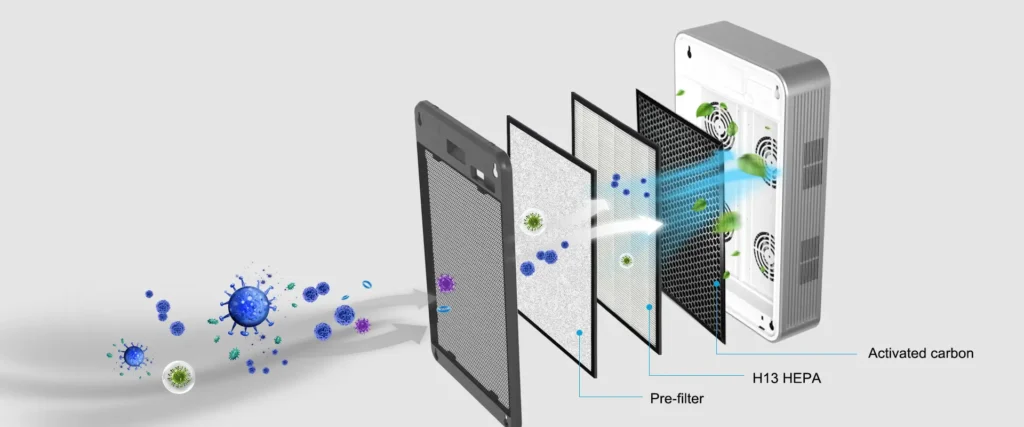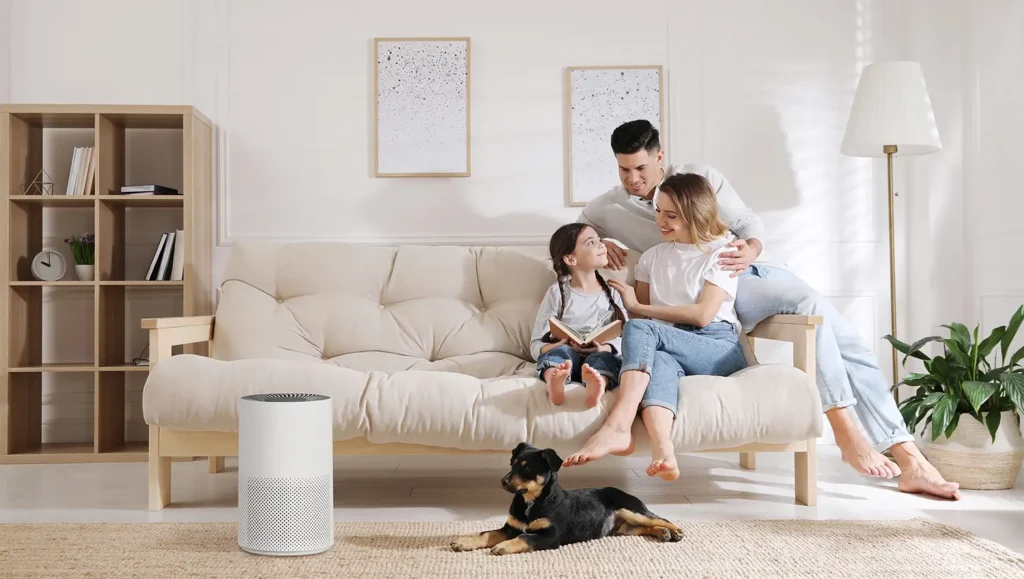Les lampes de sel de l'Himalaya NE purifient PAS l'air intérieur. - purificateurs d'air do. Dans cet article, nous expliquons pourquoi il ne faut pas se fier aux méthodes de commercialisation des lampes de sel, qui sont censées purifier l'air.
Les revendications ? Certains fabricants insistent sur le fait que les lampes de sel de l'Himalaya ne se contentent pas d'éclairer la maison. design des armoires de chambre à coucher. Ils sont également présentés comme des purificateurs d'air, qui peuvent améliorer la qualité de l'air que nous respirons. En outre, ces vendeurs insistent sur le fait qu'ils peuvent réduire l'asthme et les allergies et améliorer le sommeil.
Par exemple, consultez la description du produit de cette lampe à sel de l'Himalaya en vente :
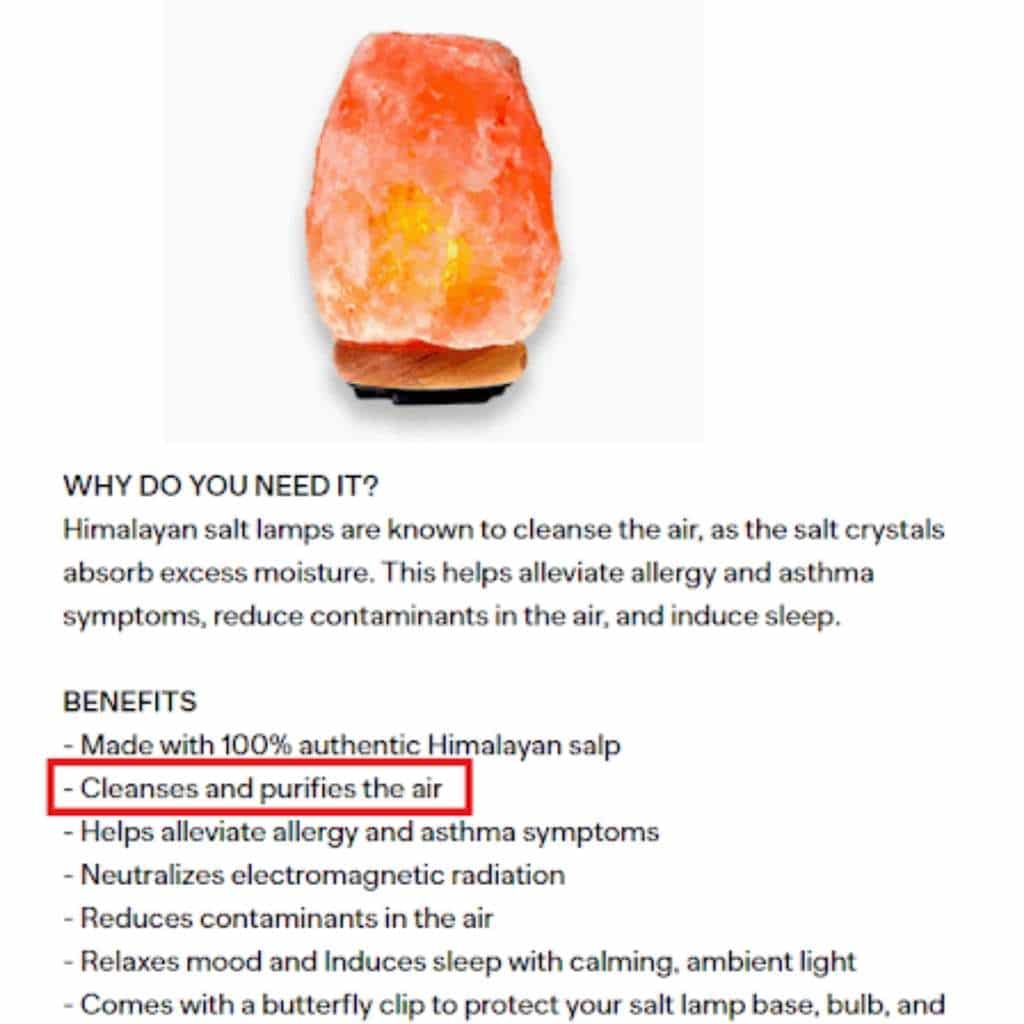
Ces avantages peuvent sembler impressionnants, mais il n'y a pas beaucoup de preuves scientifiques à l'appui.
Mais lesquelles sont vraies ? Lisez ce qui suit pour découvrir les véritables avantages et les mythes des lampes de sel.
Qu'est-ce qu'une lampe au sel de l'Himalaya ?

Les lampes de sel de l'Himalaya sont des lampes en cristal récoltées à partir de sels de roche ambrés. Vendues dans le commerce sous forme de lampes, ces lampes d'ambre naturel dégagent une ambiance apaisante en raison de leur nature. Pour l'utiliser, il suffit de placer une ampoule dans son espace creux, et elle émet une lueur rougeâtre et rose qui met de bonne humeur.
Bien qu'il s'agisse entièrement d'un produit décoratif, d'autres personnes l'achètent en croyant aux nombreux bienfaits qu'il possède pour la santé.
Retracer son origine
Les lampes de sel de l'Himalaya proviennent d'une chaîne de montagnes appelée Himalaya, qui s'étend sur environ 1 500 miles à travers le Népal, le Pakistan, le Bhoutan et l'Inde.

Les véritables lampes de sel de l'Himalaya proviennent du Pakistan, de la mine de sel de Khewra. Les mineurs récoltent ces roches de couleur rougeâtre, blanche et rose.
On pense que le sel existe depuis très longtemps dans cette région. distinct avec du sel de table . La seule différence est qu'il contient des minéraux qui donnent une couleur rose.
Certaines lampes de sel vendues en ligne sont des fausses, qui sont plus durables et donnent une lumière rougeâtre plus brillante. Les vraies sont fragiles et donnent une lumière plus faible.
Les lampes au sel de l'Himalaya sont-elles bonnes pour la santé ?
Les lampes de sel de l'Himalaya ne sont pas mauvaises en soi. Cependant, elles peuvent constituer une menace si elles ne sont pas utilisées correctement.
Les lampes de sel sont-elles dangereuses ?
Les lampes de sel sont de simples lampes décoratives et ne possèdent aucun effet négatif connu. Vous pouvez donc les utiliser si vous aimez la chaleur et le calme qu'elles procurent. Veillez toutefois à conserver la lampe dans un endroit sûr, peu ou pas fréquenté, afin d'éviter qu'elle ne soit renversée. En outre, appliquez les conseils généraux de sécurité incendie pour éviter les accidents.
Les lampes de sel sont-elles toxiques ?
La lampe de sel n'est généralement pas toxique, mais elle peut le devenir pour les animaux domestiques et les enfants, notamment en raison de leur curiosité. Une lampe à sel n'est pas nocive pour les animaux domestiques jusqu'à ce que votre animal s'en approche et l'ingère. De tous les animaux domestiques, les chats sont les plus curieux, et lorsqu'ils consomment trop de sel, cela peut causer des problèmes de santé. toxicité du sel. Pour éviter cela, gardez votre lampe à sel hors de portée de vos animaux de compagnie.
Les lampes de sel sont-elles un canular ? Est-ce que ça marche ?
On ne peut nier les caractéristiques esthétiques des lampes de sel, notamment leur couleur rose, l'ambiance et l'environnement apaisant qu'elles procurent. Mais si l'on considère les supposés bienfaits pour la santé et les capacités de purification de l'air, ces caractéristiques ne sont toujours pas prouvées scientifiquement et sont considérées comme fausses.
Certains prétendent même que les lampes de sel produisent des ions négatifs qui purifient l'atmosphère, alors que ce n'est pas le cas. Outre le fait qu'elles procurent de la lumière et un environnement apaisant, les lampes de sel ne sont pas si différentes du sel de table ordinaire.
Comment une lampe de sel peut-elle prétendument purifier l'air ?
Les lampes au sel de l'Himalaya sont réputées améliorer la qualité de l'air et rendre l'inhalation plus saine. Mais comment un appareil d'éclairage peut-il faire cela ?
Les fabricants insistent sur le fait que les lampes de sel émettent des ions négatifs. Si vous regardez des films d'horreur, vous verrez que les chamans utiliseraient l'eau salée pour piéger les mauvais esprits.
Le sel absorbe l'eau/l'humidité de l'air et s'évapore de sa surface en dégageant des ions négatifs.
Il s'agit de comment fonctionnent les purificateurs d'air ionisants - libérer des ions négatifs pour attirer poussièreles pollens, les phanères d'animaux de compagnie et les particules de l'air et de les éloigner de l'homme.
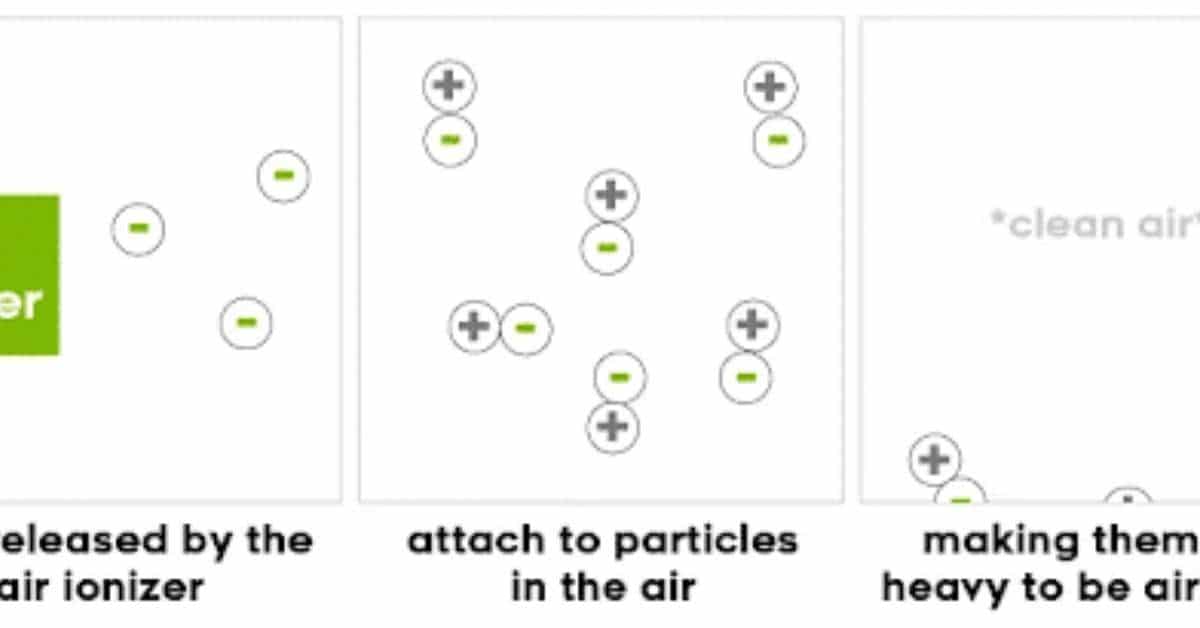
Mais les lampes de sel aident-elles à mieux respirer ?
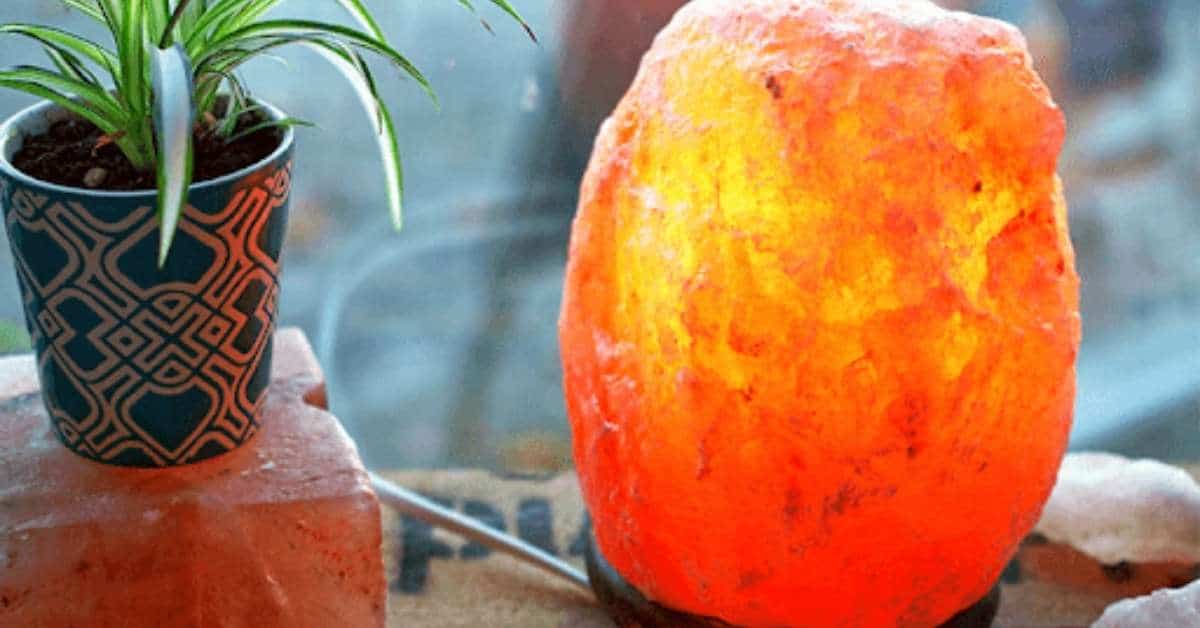
Aucune preuve scientifique ne vient étayer l'affirmation selon laquelle les lampes de sel de l'Himalaya peuvent purifier l'air en libérant des ions négatifs à partir du sel.
En effet, selon Snopes.com Il n'existe aucune preuve que les lampes de sel de l'Himalaya émettent des ions négatifs.
Le sel a une structure cubique à faces centrées qui, d'un point de vue scientifique, n'est pas censée générer des ions. Pour qu'il produise des ions négatifs, il doit être soumis à une température très élevée de plus de 2000°F. Nous ne voyons pas comment une ampoule de 15 à 45 watts peut produire une telle quantité de chaleur pour que le sel génère des ions.
Étant donné que les lampes au sel de l'Himalaya ne contiennent aucun mécanisme permettant de purifier l'air, elles ne peuvent en aucun cas aider les gens à mieux respirer.
Mais si, par hasard, on trouve le moyen de modifier la structure de la molécule pour que le sel produise des ions négatifs, il y aura des inconvénients.
En effet, si le sel libère des ions négatifs dans l'air, les éléments oxygénés risquent de se lier d'une autre manière et de produire de l'ozone.
L'ozone est une molécule de gaz nocive. Bien que la FDA déclare qu'il est généralement sans danger à une concentration de 1 000 ppm, l'ozone n'est pas considéré comme une substance dangereuse. de 0,05 partie par million Ce niveau n'est cependant pas suffisant pour débarrasser l'air des polluants et des odeurs.
Les lampes à sel sont-elles mauvaises pour les chiens ?
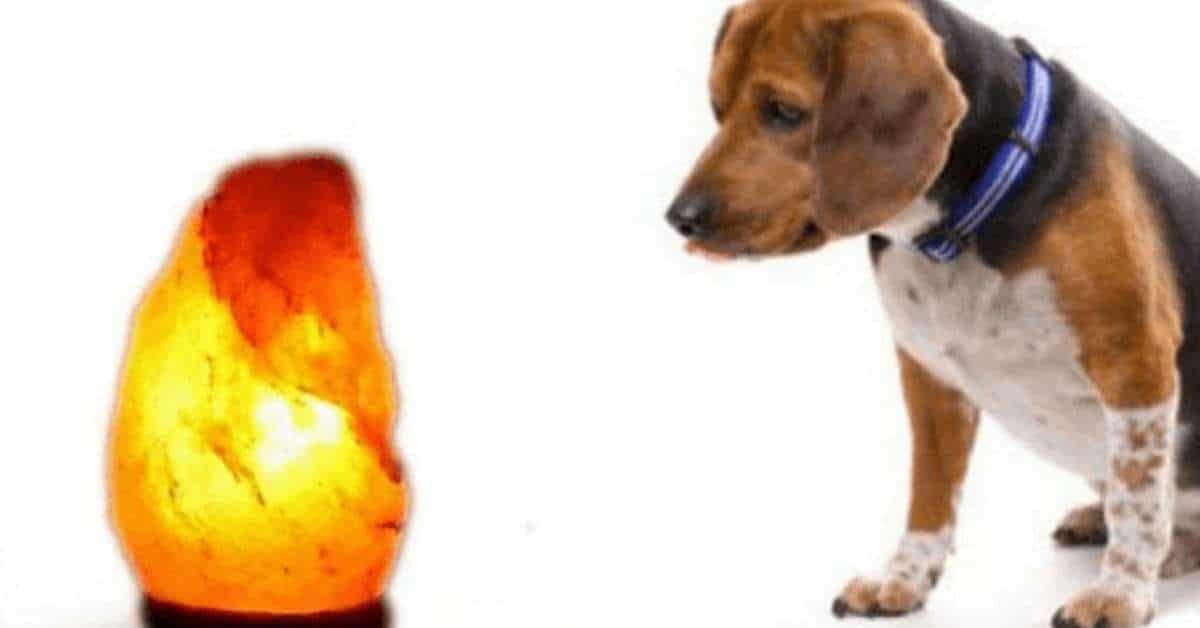
Si les gens utilisent les lampes de sel pour créer une ambiance apaisante, ils ne se rendent pas compte que les animaux de compagnie peuvent en faire quelque chose de bon à lécher. Les vétérinaires affirment qu'il n'est pas bon pour les animaux de compagnie de manger trop de sel, car cela peut entraîner des problèmes de santé.
Si vous laissez votre chien ou votre chat lécher une trop grande quantité de la lampe à sel, cela peut le blesser ou même le tuer.
Les lampes de sel de l'Himalaya tuent-elles les virus ?
Selon le WebMD Selon certaines études, les ions négatifs/positifs peuvent tuer les germes. Mais à ce jour, on ne sait pas exactement comment la destruction des germes a lieu. Comme mentionné ci-dessus, il n'y a même pas de preuve que le sel libère des ions négatifs. De plus, il n'existe aucune preuve que les lampes de sel de l'Himalaya peuvent tuer les virus.
Les bienfaits de la lampe à sel de l'Himalaya pour la santé
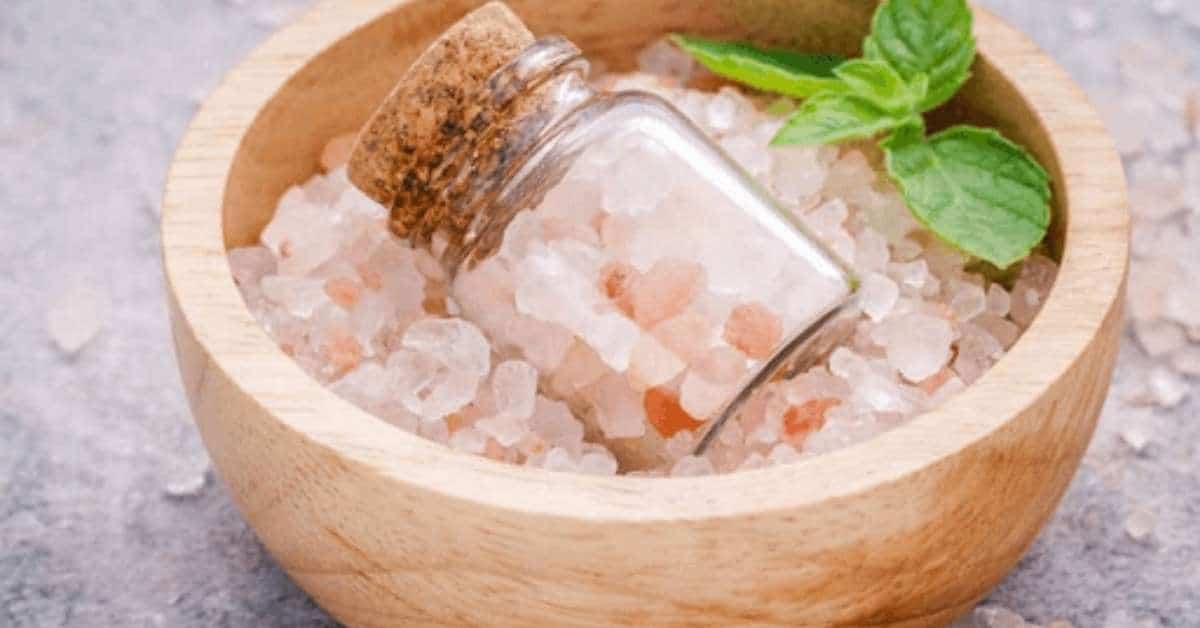
Maintenant qu'il est clair que les lampes au sel de l'Himalaya n'améliorent pas la qualité de l'air, peuvent-elles être utilisées pour améliorer votre santé ?
Dépression et anxiété
Certaines études ont montré que des concentrations élevées d'ions négatifs peuvent réduire légèrement les niveaux de dépression. Cependant, cela n'a pas beaucoup d'effet sur la dépression. l'anxiété ou dormir.
Dans une étude où des souris sont soumises à de fortes concentrations d'ions chargés négativement, les niveaux de sérotonine ont été considérablement améliorés. La sérotonine est une hormone clé qui stabilise l'humeur et les sentiments.
Asthme et allergies
Certaines publicités affirment même que les lampes de sel peuvent réduire l'asthme et les allergies. A Examen de 2013 de 33 autres études réalisées entre 1957 et 2012 affirment que, collectivement, l'exposition à des ions négatifs ou positifs joue un rôle significatif dans la fonction respiratoire, comme l'asthme et les allergies.
Mais même si les ions négatifs améliorent la santé et le bien-être des personnes, il n'y a pas beaucoup de preuves que les lampes de sel émettent ces ions, n'est-ce pas ?
Effets secondaires des lampes au sel de l'Himalaya
La lampe de sel de l'Himalaya est de plus en plus populaire pour ses bienfaits esthétiques. Mais elle n'est pas sans effets secondaires. Voici quelques-uns de ces inconvénients.
Risque d'incendie potentiel
En tant qu'appareil électrique, les lampes de sel de l'Himalaya peuvent, comme tous les autres appareils électriques, présenter un risque d'incendie. Ce risque peut être dû à une mauvaise utilisation du produit ou à un mauvais câblage. Si vous avez acheté une lampe de sel de l'Himalaya ou si vous souhaitez le faire, surveillez les variateurs de lumière. Assurez-vous que ces interrupteurs ne sont pas défectueux ou susceptibles de surchauffer.
Peu sûr pour les enfants
Les lampes de sel étant connues pour être lourdes, les placer sans précaution peut les faire tomber et blesser les enfants. Par conséquent, si vous possédez une lampe de sel Himalaya, gardez-la hors de portée des enfants. Mais ne la placez pas sur une étagère haute, de sorte qu'elle ne causerait que peu ou pas de dégâts en cas de chute. Ou trouvez un endroit stable, solide et sûr pour ranger la lampe.
Dangereux pour les animaux domestiques
Les animaux domestiques sont attirés par les lampes à sel et lèchent souvent le sel. Une consommation excessive entraîne une toxicité du sel, et les animaux peuvent vomir, devenir somnolents et avoir des crises, pour n'en citer que quelques-unes. Veillez donc à ce que votre lampe à sel soit sécurisée et inaccessible aux animaux domestiques, en particulier aux chats, qui peuvent grimper sur les étagères pour accéder à la lampe à sel.
Avertissements concernant la lampe de sel de l'Himalaya
Que vous achetiez une nouvelle lampe de sel Himalaya ou que vous en possédiez déjà une, vous devez vous assurer que vous ne vous exposez pas à un danger. Voici quelques conseils pour vous aider à utiliser votre lampe de sel en toute sécurité.
- N'achetez que des produits sûrs. Comme indiqué précédemment, les lampes de sel peuvent présenter un risque d'incendie si leur câblage est défectueux ou si elles ont tendance à surchauffer. Pour éviter cela, n'achetez que des produits sûrs portant l'autocollant de sécurité UL (Underwriters Laboratories). Cet autocollant atteste que le câblage du produit a été certifié pour la sécurité.
- Tenir à l'écart des enfants et des animaux domestiques. Les effets de l'accessibilité des lampes de sel aux enfants et aux animaux domestiques ont été évoqués précédemment. Par conséquent, pour éviter les blessures ou la toxicité du sel, conservez votre lampe de sel dans un endroit sûr et difficilement accessible.
- Utilisez les conseils de sécurité recommandés. Ces conseils comprennent l'achat d'une lampe de sel authentique et le respect du mode d'emploi du fabricant. De plus, si vous gardez une lampe de sel allumée toute la journée, veillez à l'éteindre lorsque vous quittez votre domicile, comme vous le faites pour vos autres appareils électriques. Vérifiez que le câblage n'est pas défectueux et qu'il n'y a pas de risque d'inflammation.
- Les lampes de sel ne peuvent pas être laissées allumées en toute sécurité. Certaines personnes apprécient la chaleur produite par les lampes de sel tout au long de la journée, tandis que d'autres préfèrent en profiter uniquement la nuit. Aucune de ces situations ne présente de risque, sauf si vous laissez votre lampe de sel allumée lorsque vous ou personne n'est à la maison. Mais même si vous êtes à la maison, assurez-vous qu'elle est en bon état et qu'elle peut être utilisée.
Résultat final
En termes de purification de l'air, il n'existe aucune preuve scientifique que les lampes au sel de l'Himalaya peuvent assainir l'air de votre maison. Oui, elle a une couleur rosée apaisante. Mais à part cela, c'est la seule chose que vous pouvez obtenir d'une lampe de sel - ses caractéristiques décoratives.
Il n'émet pas d'ions négatifs susceptibles d'assainir l'air, de réduire le niveau de stress ou de diminuer le niveau de dépression.
Si vous avez besoin d'un appareil qui nettoie l'air de la poussière et des virus, sans jamais blesser vos animaux domestiques, choisissez un Véritable purificateur d'air HEPA avec lumière UV . Le filtre True HEPA retient les minuscules particules jusqu'à 99,97% et jusqu'à une taille de 0,03micron. En même temps, la lumière UV qui passe à travers le filtre va tuer le virus, même le COVID-19.


